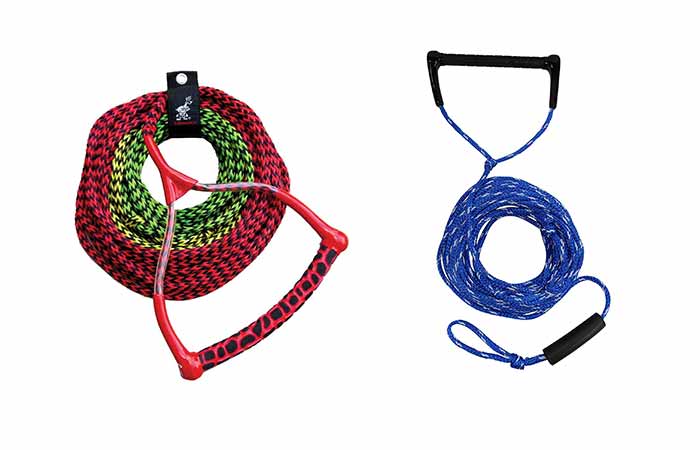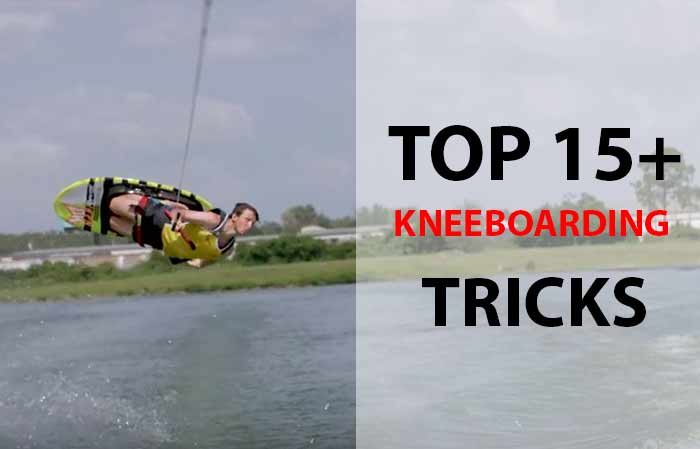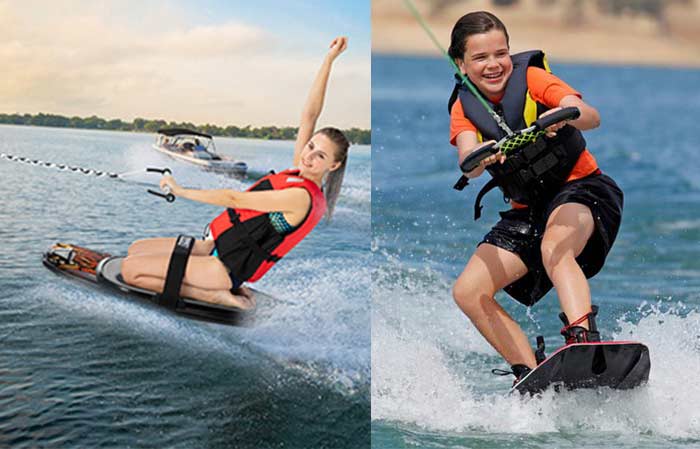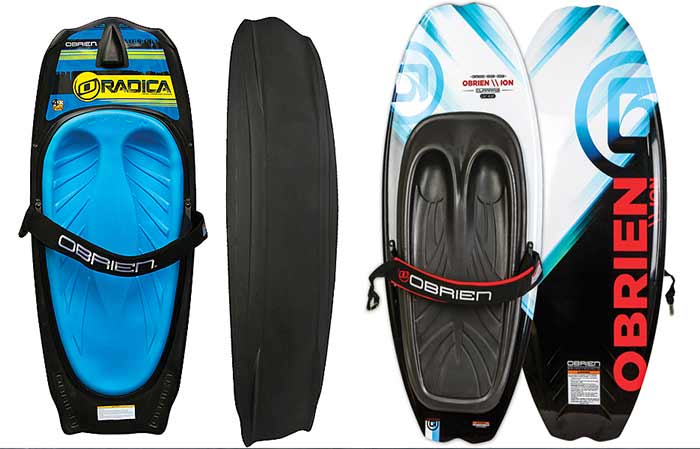How to Kneeboard in 4 Basic Steps
Kneeboarding is a fun and exciting water sport that anyone can learn. The essential items you need to start off include a kneeboard, a tow rope, body of water and motorboat.
To kneeboard, you basically kneel on the board, sit on your heels, secure yourself to the deck with a strap then grab on to the tow rope as the boat pulls you through the water. Modern kneeboards come with features that allow beginners to start off easily without having to worry about falling off.
Once you get a grip of it, kneeboarding can be a great way to enter other towable board water sports such as surfing and skiing. Following are the steps to learn it plus tips to stay safe.
Preparation
The first step is to preparing not only the equipment but also yourself. Kneeboarding requires the right equipment and skills to pull off properly. This goes for beginners as well as experts in this sport.
You need the following equipment:
A Tow Rope
The tow rope kneeboarding should be long enough for the right tow. The non-stretch types are the ideal option of starters. As a learner, stretching ropes may present an extra level of difficulty. As you become better at it, you’ll use the low-stretch then progress accordingly.
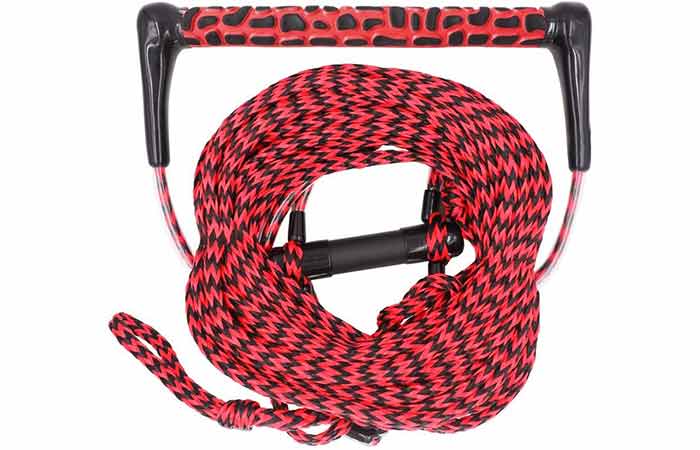
For a comfortable and firm grip, the handle that come with the ropes should be of the right thickness and width
Further Reading: Best Tow Ropes for Kneeboarding
Kneeboard
You have the choice of a recreational or competitive kneeboard. As a beginner, the recreational one is the best option as it’s cheaper and readily available. It’s also more stable making it easier to balance.

Recreational kneeboards thick and buoyant meaning they’ll easily help you stay afloat. Some even come with nice beginner-friendly features including fins and inbuilt hook.
Further Reading: The Best Kneeboards
Tow Boat
The towboat you pick on should manage speeds of at least 15 to 20 mph (28 to 32 km/h). As a beginner, you’ll likely go slower than this speed but will eventually catch up to the speed range above.
Certified Life Vest
Vests are important regardless of your skill level. This is because waves are unpredictable and you’ll often fall off the board no matter how skillful you are. It is an invaluable gear especially if you are newbie with little or no swimming skills.
Calm water body
The ideal water body, be it a lake or sea, for learning is one that is calm and free of obstacles. Avoid heavy waves and waters that are crowded with other riders and watercraft
How to Start
The second step is learning how to start. You can start in two positions, lying on stomach or kneeling while your legs are strapped to the board. The lying position is the best and easiest position for most beginners. It lowers your center of gravity hence making your starts easy and stable while minimizing the falling impact.
The kneeling position is ideal if you are starting off land on boards that lack integrated hooks and fins. Following are the steps
- Warm up; do some basic stretches, breath while visualizing yourself on the board having fun.
- Loosen the knee strap and position it in a way that it is near your torso but far from your knees.
- Lay on your belly and simply float on the board without any motion from the tow boat. While in this position, your feet should dangle in the water at the tail of the kneeboard.
- Once you are comfortable in the floating position signal your driver to start the boat.
- When the boat starts to move, place the handle in the hook and firmly hold unto the sides of the kneeboard with your elbows resting on the kneeboard.
You can also start outside water especially with kneeboards without a hook. To start from land simply sit on your heels, secure yourself on the board using the strap, get the tow rope, signal your driver, and then slightly lean back as the boat starts to go.
If the board has a hook, you can as well attach the handle to it and hold to sides of the board.
As a starter, holding unto both the board and handle while balancing at the same time can be a bit difficult to pull off. Having the handle on the hook will help you focus on the balancing as the board is towed.
Before any movement, ensure the tow rope is tight between you and the tow boat. This prevents the jacking motion that often leads to falling at the start.
How to Get Up on a Kneeboard
Getting up is the next step after you’ve mastered your starts. At this point, you can float and balance on your belly while being towed. The following are the steps to get you up from the laying position
- slowly move your knees from the flat profile towards your elbows
- Tuck your knees all the way into position so your shins are flat then sit on your heels.
- Tighten the strap over your thighs.
- Remove the tow rope handle from the hook and use your hands to hold it(handle) firmly. Your hands should be extended before you, palms facing downwards. This prevents fatigue and keeps you in better control
- Signal your boat driver to increase speed
- Shift your weight to back of the board as the boat increases speed.
- Once you gain speed, learn to move on a straight line first. You can then learn how to steer as the boat moves.
Controlling the Speed & Turning
As a beginner, you should start at low speeds. Increase the speed as you progress. You should let your boat driver know what speed you’re comfortable with.
From a boat driver’s perspective, the speed varies depending on a rider’s weight and skill level. The higher the weight and skill level the higher the speed. Check the following chart for a guideline
- 5-8 mph tow speed; less than 50lbs kneeboarder weight
- 8-12 mph tow speed; 50-100lbs weight of kneeboarder
- 12-16 mph tow speed; 100-150lbs kneeboarder weight
- 16-20 mph tow speed; more than 150lbs kneeboarder weight
Once you are comfortably riding at some reasonable speed it is time to turn or steer.
To turn the kneeboard, simply lean your head and shoulders in the direction you would like to turn; mostly the direction the boat is going.
This will turn the front of the board and allow you to apply pressure to the edge of the board in the direction you are steering. To make stronger turns you also need to turn your hip into the direction you want to go
With time, you’ll get the idea of how much leaning is needed for what speed and what degree of turn.
These steps are the basics and, with time, you’ll do them faster and even combine some tasks. For example, medium-level kneeboarders are able to hold unto the tow rope with one hand and use the other to strap their thighs on the board without falling off.
Hand Signals
These are signals between the kneeboarder and the tow boat driver to indicate various aspects. Both the kneeboarder and the driver should know them since communication by words may not be possible owing to the speed and sound of the water.
They’re as follows:
Speed up
The signal for speeding up is a thumbs up with either hand.
Slow down
To tell the tow boat driver to slow down, you use the thumbs down signal with either hand.
OK
The sign to show that the speed (or everything) is okay is a ring formed with the index finger and the thumb with the three fingers spread out.
Turn
This signal can be used by both the kneeboarder and the driver of the tow and indicates that they need to turn to a direction or are turning respectively. You point one finger in the air then make a circle with it followed by pointing in the direction you’re going to turn or want to turn.
Back to the dock
Patting the top of your head signals the need to return to the dock either by the kneeboarder or the tow boat driver.
Stop/Cut motor
The driver of the tow boat will stop if you signal with the slashing motion at your throat. An observer on the side can also make the sign with the same meaning.
I’m ok
After a fall, you should always indicate to the driver and observer that you’re okay by clasping both hands above your head.
These are standard signals for any water sport and should be learned for safety purposes.

Water Skier’s Safety Codes
These are codes that should be adhered to for safety no matter the water sport you’re engaging in.
They’re are follows:
- Always wear a life vest.
- Check your equipment before the start.
- Only give the starting signal when you’re ready.
- Don’t kneeboard near other swimmers, boats or docks.
- Don’t wrap the handle on any part of your body.
- Avoid kneeboarding near land or shallow waters.
- Aim to fall either backwards and to the sides rather than forwards.
- Learn the hand signals above before the activities.
- When you fall into the water and other people are kneeboarding or skiing around you, lift the side of the board out of the water to signal to the others that you’re there to prevent injuries.
- Avoid kneeboarding until you’re exhausted.
- Never kneeboard at night even with the moon or floodlights.
- Ensure the motor is turned off before entering or exiting the tow boat.
- Always have someone observing from the sides as you kneeboard even when you’re an expert.
These guidelines will ensure you’re safe at all times no matter the water sport you’re engaging in.
FAQs
Is kneeboarding bad for your knees?
If done correctly with the right board, injuries are rare. But in cases where riders are performing extreme tricks and stunts, injuries are likely to happen.This is mostly because of the impact of falling on and bouncing from water.
There are also possibilities of hitting other objects doing the stunts. In addition to the safety codes above, here are tips and ideas to avoid the pain and injuries
- Do not go to kneeboard if you have any injuries
- Choose a kneeboard that is made from the right materials. You can as well fit the boards with additional fitting for comfort
- Stretch before starting to kneeboard
- Maintain good form or the right posture all throughout the activity: back straight while shoulders leaning slightly back. Arms bent and close to the body. Outside of your hips on top your heels not heels directly below your bottom
How do you do kneeboard tricks?
You can perform countless tricks while kneeboarding but this almost entirely depends on your experience in the sport. If just starting, learn the fundamentals first. If you’re an intermediate or an advanced rider, check out this list of some of the top kneeboard tricks.
Further Reading

